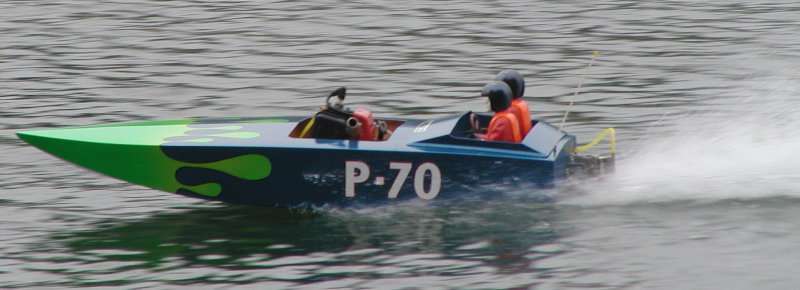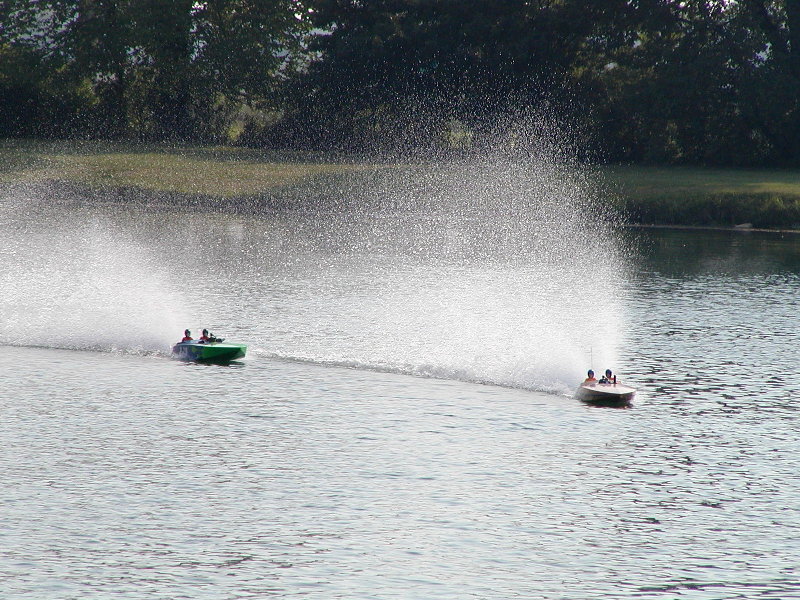Tech Article ...by Nelson King
![]()
Some really good crackerbox setup information...
Nelson King was kind enough to share his experience with a reader that had some questions regarding a Crackerbox boat. The questions and answers are below, along with some pictures that were provided - editor
 Hi
Glowplug41, I am ndking88 and will attempt to provide the information you have
requested. I have only built one Crackerbox so I don't consider myself an expert
in the design and setup of a Crackerbox but I have raced against some of the
best so here goes:
Hi
Glowplug41, I am ndking88 and will attempt to provide the information you have
requested. I have only built one Crackerbox so I don't consider myself an expert
in the design and setup of a Crackerbox but I have raced against some of the
best so here goes:
Q. I need to know where the CG should be?
A. This is difficult to answer since it will vary based on the design of your boat. If your design has a fair amount of rocker at the keel and chine a CG of 28% to 30% of the overall length measured from the transom seems to work well. For a boat with a straight keel the CG could be farther forward. How far forward will depend on the deck configuration. For a flat, level deck that provides no down force at speed the CG should be further forward than if the deck slopes toward the bow. In this case the CG could be from 30% to 35% of the overall length. A safe bet would be to place your CG at 30% and make small additions of weight to the bow or stern as needed.
Q. Where should I place the skeg or fin?
A. First
lets examine what a skeg does. Without a skeg it would be near imposable to turn
your  Crackerbox. Due to the relatively flat bottom a CB would slide
sideward and not respond to rudder input so the skeg is needed to provide a
pivot point to turn on. The skeg needs to be deep enough to stay engaged in the
water, especially in the turns, but not so deep as to trip the boat to the side
should it skip over another boats wake. As for placement almost all the boats I
have seen have the skeg placed at or near the CG. From my experience, I prefer
the skeg placed a little farther forward. A boat that has the skeg close to the
stern (and rudder) will be skittish with radical response to the rudder input.
Placing the skeg 4" to 6" forward of the CG will reduce this tendency.
Crackerbox. Due to the relatively flat bottom a CB would slide
sideward and not respond to rudder input so the skeg is needed to provide a
pivot point to turn on. The skeg needs to be deep enough to stay engaged in the
water, especially in the turns, but not so deep as to trip the boat to the side
should it skip over another boats wake. As for placement almost all the boats I
have seen have the skeg placed at or near the CG. From my experience, I prefer
the skeg placed a little farther forward. A boat that has the skeg close to the
stern (and rudder) will be skittish with radical response to the rudder input.
Placing the skeg 4" to 6" forward of the CG will reduce this tendency.
Q. Is a Homlite 22cc enough motor?
A. Enough for what? From my observations a stock, air-cooled motor of that size can provide hours of enjoyment. However if you intend to compete in sanctioned events you may want more power. I have a half dozen or more plaques and trophies from events I have competed in running a modified 25cc Homelite. There is more to winning than speed.
Q. What props would be good?
 A. Wow, there are a lot of variables that
influence prop selection. This will depend on available power, hull
configuration, hardware used, drive configuration and purpose to name a few.
Assuming the engine you plan to use is stock or near stock either a Octura X470
or Prather 270 would be an inexpensive prop to start with.
A. Wow, there are a lot of variables that
influence prop selection. This will depend on available power, hull
configuration, hardware used, drive configuration and purpose to name a few.
Assuming the engine you plan to use is stock or near stock either a Octura X470
or Prather 270 would be an inexpensive prop to start with.
Q. What should it weigh?
A. I have seen CB boats from 14lb to 20lb plus. Personally I don't feel that lightweight is necessarily better and believe too much is made of that. Mine is 18lb+ and I am very happy.
Q. Does anyone have a crackerbox up in your part of the country?
Could
someone send me a picture of their CrackerBox?
Could someone send me pictures
of a crackerbox actually running?
Does anyone race these?
Any basic feed
back on CrackerBox?
 A. I'll try to sum these up for you. I am in
Northern Ohio and the club I belong to had only two boats of this class two
years ago and now there are 6 or 7 and I know of at least two more being built.
They are becoming quite popular here. I am also aware of regional and national
events where up to 20 CB have registered for competition.
A. I'll try to sum these up for you. I am in
Northern Ohio and the club I belong to had only two boats of this class two
years ago and now there are 6 or 7 and I know of at least two more being built.
They are becoming quite popular here. I am also aware of regional and national
events where up to 20 CB have registered for competition.
I hope the information provided here helps and that you have hours of enjoyment with your Crackerbox.
Nelson
King
This email address is being protected from spambots. You need JavaScript enabled to view it.

